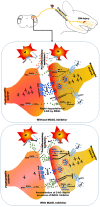Targeting Peripherally Restricted Cannabinoid Receptor 1, Cannabinoid Receptor 2, and Endocannabinoid-Degrading Enzymes for the Treatment of Neuropathic Pain Including Neuropathic Orofacial Pain
- PMID: 32093166
- PMCID: PMC7073137
- DOI: 10.3390/ijms21041423
Targeting Peripherally Restricted Cannabinoid Receptor 1, Cannabinoid Receptor 2, and Endocannabinoid-Degrading Enzymes for the Treatment of Neuropathic Pain Including Neuropathic Orofacial Pain
Abstract
Neuropathic pain conditions including neuropathic orofacial pain (NOP) are difficult to treat. Contemporary therapeutic agents for neuropathic pain are often ineffective in relieving pain and are associated with various adverse effects. Finding new options for treating neuropathic pain is a major priority in pain-related research. Cannabinoid-based therapeutic strategies have emerged as promising new options. Cannabinoids mainly act on cannabinoid 1 (CB1) and 2 (CB2) receptors, and the former is widely distributed in the brain. The therapeutic significance of cannabinoids is masked by their adverse effects including sedation, motor impairment, addiction and cognitive impairment, which are thought to be mediated by CB1 receptors in the brain. Alternative approaches have been developed to overcome this problem by selectively targeting CB2 receptors, peripherally restricted CB1 receptors and endocannabinoids that may be locally synthesized on demand at sites where their actions are pertinent. Many preclinical studies have reported that these strategies are effective for treating neuropathic pain and produce no or minimal side effects. Recently, we observed that inhibition of degradation of a major endocannabinoid, 2-arachydonoylglycerol, can attenuate NOP following trigeminal nerve injury in mice. This review will discuss the above-mentioned alternative approaches that show potential for treating neuropathic pain including NOP.
Keywords: CB2-selective agonists; endocannabinoid-degrading enzyme inhibitors; neuropathic orofacial pain; neuropathic pain; peripherally restricted CB1 agonists.
Conflict of interest statement
The authors declare no conflict of interest
Figures

References
-
- Merskey H. Classification Chronic Pain-Descriptions Chronic Pain Syndromes and Definitions of Pain Terms. IASP Press; Seattle, WA, USA: 1994. Part III Pain Terms, A Current List with Definitions and Notes on usage; pp. 207–214.
-
- Schaefer C., Mann R., Sadosky A., Daniel S., Parsons B., Nieshoff E., Tuchman M., Nalamachu S., Anschel A., Stacey B.R. Burden of illness associated with peripheral and central neuropathic pain among adults seeking treatment in the united states: A patient-centered evaluation. Pain Med. 2014;15:2105–2119. doi: 10.1111/pme.12502. - DOI - PMC - PubMed
Publication types
MeSH terms
Substances
Grants and funding
LinkOut - more resources
Full Text Sources

